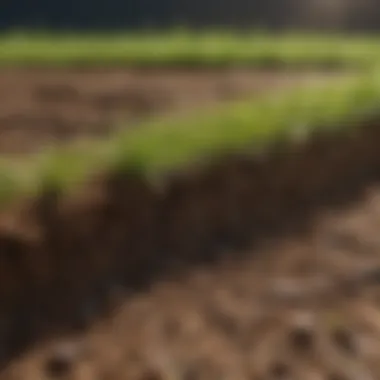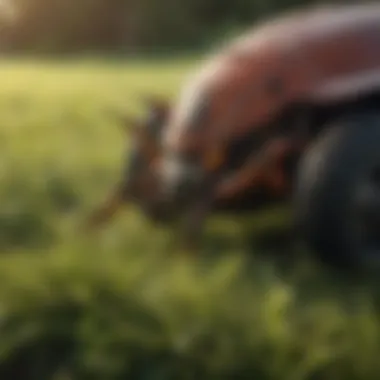Effective Strategies for Thicker Centipede Grass


Overview of the Topic
Definition and Importance
Centipede grass, a warm-season grass, is known for its light green color and low maintenance needs. It is widely valued in the southern regions of the United States, especially in the Southeast. This grass type is particularly important for creating lush lawns that require minimal effort compared to other grass types. Achieving a thicker centipede grass lawn provides not just aesthetic value but also enhances the overall health of the turf, which can lead to reduced weed growth and better pest resistance.
Current Trends
Recent trends in lawn care have shifted towards sustainable practices. Homeowners increasingly focus on reducing water use, applying less fertilizer, and fostering healthier soil to cultivate thicker centipede grass. The rise of organic gardening methods is also notable. There is a growing interest in using natural amendments and non-chemical pest control methods. These trends align with an increasing environmental awareness among consumers.
Key Techniques and Practices
Step-by-Step Guide
- Soil Preparation: Start with a soil test to determine pH and nutrient levels. Centipede grass thrives in slightly acidic soil (pH 5.5 to 6.5).
- Fertilization: Use a recommended fertilizer for centipede grass. Typically, slow-release nitrogen fertilizers work well. Apply in the late spring for optimal growth.
- Watering: Ensure the grass receives at least one inch of water weekly. Drip irrigation systems can be efficient for this purpose.
- Aeration: Aerate your lawn once or twice a year to enhance soil permeability. This helps nutrients and water reach the roots more effectively.
- Mowing: Maintain a mowing height of about one to two inches to promote denser growth. Avoid cutting more than one-third of the grass height at a time.
Tools and Equipment Needed
To properly maintain a centipede grass lawn, the following tools are beneficial:
- Lawn mower: A rotary mower is suitable.
- Aerator: Either spike or plug aerators can be used.
- Soil test kit: Helps determine nutrient needs.
- Sprinkler system: An efficient way to ensure even watering.
Challenges and Solutions
Common Obstacles
While centipede grass is relatively easy to care for, several challenges can hinder its growth. These include pest infestations, improper watering, and nutrient deficiencies. Pests such as grub worms and chinch bugs can damage the grass if not managed properly. Additionally, over or under watering can lead to thinning and other health problems.
Innovative Solutions
- Integrated Pest Management: Using a combination of natural predators and barriers can effectively control pest populations without chemicals.
- Soil Amendments: Incorporate organic matter, such as compost, to enhance soil structure and nutrient content.
- Adapted Irrigation Techniques: Employing a smart watering system that adjusts based on weather conditions can optimize water usage.
"Sustainable practices, such as organic amendments and water conservation, can greatly improve the health of centipede grass."
By addressing these challenges with innovative solutions, homeowners can cultivate a thicker, healthier centipede grass lawn that thrives throughout the seasons.
Understanding Centipede Grass
Understanding centipede grass is critical for anyone looking to enhance their lawn’s thickness and overall health. This warm-season grass species, often favored for its low maintenance, provides a lush green appearance. However, achieving a denser turf requires knowledge of its specific traits and necessary growing conditions.
Centipede grass is particularly known for its unique growth habits and resilience in certain climates. It thrives in areas with moderate rainfall and can adapt to a range of soil types, though it prefers sandy and acidic soils. The significance of understanding these features lies in the informed decisions that can be made regarding care and cultivation. Thus, addressing soil composition, fertilization, and watering appropriately can lead to a healthier, thicker lawn.
Moreover, the environmental and economic benefits of cultivating centipede grass cannot be overlooked. Lower water requirements compared to other grass types make it an attractive option for sustainability. By implementing proper strategies, you can not only have a beautiful lawn but also conserve resources effectively.
"The richness of a lawn depends heavily on understanding the grass it holds."
Additionally, knowing how centipede grass behaves under varying conditions can help in troubleshooting common issues like pest invasions or nutritional deficiencies. This knowledge equips gardeners and agriculturists to take proactive measures, leading to long-term health and aesthetics of the turf.
Characteristics of Centipede Grass
Centipede grass exhibits distinctive characteristics that set it apart from other lawn grasses. It is characterized by broad, flat blades that give it a soft and inviting appearance. Its growth habit is somewhat slower than other species, making it less prone to frequent mowing when maintained properly. This grass typically has a light to medium green color, enhancing the visual appeal of lawns.
Another key feature is its capacity for self-repair. Centipede grass can recover from minor damages efficiently, which is a crucial trait for maintaining an enduring lawn aesthetic. Its extensive rooting system also allows it to tap into moisture deeper in the ground, making it somewhat drought tolerant.
However, centipede grass does have preferences when it comes to soil pH levels, ideally thriving in slightly acidic conditions (pH 5.5-6.5). Thus, its unique characteristics must be considered in management practices to foster optimal growth and health.
Ideal Growing Conditions
To cultivate a healthy and thick centipede grass lawn, understanding and creating ideal growing conditions is paramount. Centipede grass prefers warm, humid climates, which makes it well-suited for the southeastern United States. Ideal temperatures range between 70°F and 90°F.
These grass types also benefit from full sunlight, needing at least six hours of direct sunlight every day. In shaded areas, centipede grass can struggle to achieve density and might become weak.
Soil quality plays an essential role in the growth of centipede grass. It favors well-draining sandy loam soils rich in organic matter. The soil's drainage capacity is vital, as standing water can lead to root diseases, harming the grass health.
Additionally, sufficient moisture levels must be maintained but not overdone. Overwatering can lead to fungal diseases, while drought can stress the grass, hindering its growth potential. Implementing proper watering schedules is crucial for sustaining the growth conditions that centipede grass requires.
Soil Preparation
Soil preparation is a crucial step in establishing a thriving centipede grass lawn. Proper soil conditions provide the foundation for healthy growth. When the soil is adequately prepared, it enhances nutrient availability, improves drainage, and promotes root development. This process involves several key factors that can affect the thickness and overall health of your centipede grass.
Soil Testing and Analysis
Understanding the current state of your soil is fundamental. Soil testing helps in determining the nutrient levels, pH, and texture of the soil. Collect samples from various areas of your lawn, as soil conditions can vary significantly within small distances. Send these samples to a lab for testing. The results will highlight deficiencies and excesses in nutrients, which will inform your amendment strategy. Knowing your soil's characteristics allows for tailored interventions that improve thickness and resilience in centipede grass.
Amendment Basics
Organic matter incorporation
Incorporating organic matter into the soil significantly benefits centipede grass. This practice enhances soil structure, increases moisture retention, and feeds beneficial microorganisms. Organic matter, such as compost or well-rotted manure, improves soil aeration and drainage. This is particularly important for centipede grass, which prefers a well-draining soil structure.
Another key characteristic of organic matter is its slow-release nutrient profile. Instead of providing immediate feeding, it releases nutrients over time, which aligns well with the growth requirements of centipede grass. However, the unique feature of organic matter incorporation is that it can help mitigate issues such as compaction, ultimately leading to stronger, thicker grass.


pH adjustment
The pH level of the soil significantly influences nutrient availability for centipede grass. Ideally, centipede grass thrives in slightly acidic soil with a pH between 5.5 and 6.5. Testing the pH of your soil reveals if adjustments are necessary. If your soil is too alkaline, applying sulfur can lower the pH to an optimal range. This adjustment is vital because an improper pH can lead to nutrient deficiencies or toxicities, impairing grass growth.
The unique aspect of pH adjustment is that it can be a straightforward process with appropriate methods. However, it requires monitoring, as excessive adjustments can lead to further imbalances. Regular testing after adjustments helps ensure the soil remains within the suitable pH range.
Draining Issues
Drainage issues can severely impact centipede grass health. Poor drainage leads to waterlogged conditions, which can promote diseases and inhibit root development. Identifying drainage problems early can prevent extensive damage. It might be necessary to consider installing drainage systems or modifying the landscape to improve water movement. Correcting these issues supports the effective moisture retention that centipede grass needs without the risk of rot or other water-related issues.
Proper soil preparation lays the groundwork for a lush, dense centipede grass lawn. Taking the time to understand and amend your soil can yield substantial long-term benefits.
Fertilization Strategies
Fertilization strategies are crucial in ensuring that centipede grass thrives and achieves the desired thickness. This includes selecting the right fertilizers, applying them at appropriate times, and using effective application methods. Proper fertilization fosters robust growth, enhances color, and improves drought resistance. By understanding various aspects of fertilization, one can significantly boost the overall health of centipede grass, leading to a denser lawn.
Choosing the Right Fertilizer
Slow-release vs. fast-release fertilizers
When deciding between slow-release and fast-release fertilizers, it is important to recognize their differences. Slow-release fertilizers liberate nutrients gradually over time, providing a steady supply for plants. This characteristic is beneficial because it minimizes the risk of nutrient leaching and reduces the need for frequent applications. On the other hand, fast-release fertilizers supply nutrients rapidly, leading to quick short-term growth. However, this method can result in uneven nutrient delivery and may require more careful monitoring.
The unique feature of slow-release fertilizers is their ability to maintain nutrient availability over an extended period. Their disadvantages could include higher initial costs and longer wait times for visible results. For centipede grass, slow-release options generally suit the slow growth nature of the grass well.
Nitrogen requirements
Nitrogen plays a pivotal role in the development and sustenance of centipede grass. A key aspect of nitrogen is its contribution to chlorophyll production, essential for photosynthesis and overall green color. Adequate nitrogen levels enhance grass thickness, making it healthier and more attractive.
While nitrogen is often seen as a beneficial nutrient, it is vital to apply it in moderation. Excessive nitrogen can lead to rapid growth, making grass weak and susceptible to pests and diseases. The ideal nitrogen level for centipede grass varies depending on soil conditions and other factors, emphasizing the importance of soil testing before application. Managing nitrogen requirements is thus crucial for achieving optimal grass density.
Timing and Frequency
The timing and frequency of fertilizer application have a profound impact on the effectiveness of fertilization strategies. Understanding the growth cycles of centipede grass will guide when to fertilize. Early spring is often the best time to start, as growth begins to pick up. Fertilization should occur at regular intervals, generally every three to four months in the growing season, depending on the fertilizer type used.
Application Techniques
Granular methods
Granular methods of application involve spreading solid fertilizers over the grass. This technique is popular due to its simplicity and ability to ensure even distribution. A critical benefit is the control it offers in terms of the amount of fertilizer applied. Users can adjust the granulated product based on specific lawn needs.
However, one must be cautious when using granular fertilizers as uneven applications can lead to patchy growth or increased weed competition. Timing is essential, especially if rain is expected, to avoid nutrient runoff.
Liquid application
Liquid application delivers nutrients in a solution form and is highly effective for quick absorption. This method can lead to rapid greening, making it a favored choice for immediate results. Liquid fertilizers can penetrate the soil more deeply, ensuring that the roots receive essential nutrients quickly.
The significant downside is that liquid applications may require more frequent treatments than granular options, and can sometimes lead to over-application if not measured correctly. Therefore, it is crucial to adhere to the manufacturer's instructions rigorously to avoid adverse effects.
Effective fertilization is a blend of the right products and practices applied at suitable times to achieve the desired lawn density.
Watering Practices
Watering practices are essential for establishing and maintaining a healthy centipede grass lawn. This grass type thrives in specific moisture conditions, making the management of water inputs crucial for promoting growth and density. Proper watering practices not only enhance the health of centipede grass but also optimize nutrient uptake and shield the grass from stressors such as disease and drought. Understanding the intricacies of watering frequency, depth, and techniques is vital for achieving lush and vigorous grass.
Watering Frequency and Depth
Determining the right watering frequency and depth is critical in the effort to achieve thicker centipede grass. Generally, centipede grass requires about 1 to 1.5 inches of water per week, depending on seasonal conditions and soil type.
Watering deeply, rather than frequently, encourages roots to develop deeper into the soil, fostering a more resilient grass. Watering should ideally occur early in the morning when the temperatures are cooler, thus allowing less evaporation. It is best to water until the soil is moist at a depth of around 6 to 8 inches, which benefits the root system significantly.
Irrigation Techniques
Different irrigation techniques can be utilized for centipede grass, each with its advantages and disadvantages. Choosing the correct method can significantly impact water efficiency and grass health.
Sprinkler systems
Sprinkler systems provide a widespread, even distribution of water, making them very popular for larger lawns. Their primary characteristic is their ability to cover large areas efficiently, essential for uniform grass growth.
Sprinkler systems can be set on timers, providing consistency in watering schedules. One newly installed feature in many systems is smart technology that adjusts schedules based on rainfall and soil moisture levels, maximizing resource efficiency. However, they can be less efficient on windy days, as water may drift away from intended zones, potentially leading to over-saturation in some areas and under-watering in others.
Drip irrigation
Drip irrigation offers another effective method for watering centipede grass. Its primary characteristic is delivering water directly to the soil at the plant's root zone through a network of tubes and emitters. This technique minimizes waste and evaporation, as it provides targeted watering.
Drip irrigation is especially beneficial in regions where water conservation is a high priority. Its unique feature is the ability to maintain consistent moisture levels without the wetting of the above-ground foliage, reducing the risk of disease. However, the initial setup costs can be higher, and maintenance may require attention to prevent clogging in the system.
Drought Management
Drought management is crucial for maintaining the health of centipede grass during dry periods. Implementing practices such as deep watering and using organic mulches can help retain moisture in the soil. A well-maintained grass lawn can resist drought stress better, but in times of prolonged dry spells, reducing the mowing height can also lessen moisture loss. Additionally, avoiding over-fertilization before a drought can conserve water and prevent additional stress to the grass. By being proactive in these areas, it's possible to keep centipede grass healthy and vibrant even in challenging conditions.
"Proper watering practices enhance nutrient uptake, prevent disease, and manage stressors effectively."


By focusing on the right watering strategies, you can achieve a thick and resilient centipede grass lawn.
Weed and Pest Management
Weed and pest management plays a crucial role in the health and vitality of centipede grass. Uncontrolled weeds can compete for essential nutrients, water, and sunlight, ultimately stunting the growth of the grass. Likewise, pests can cause significant damage by attacking the blades and roots of the grass. This section will explore how to effectively identify, control, and manage both weeds and pests to promote a thicker and healthier lawn.
Identifying Common Weeds
Recognizing common weeds that invade centipede grass is the first step in effective management. Some prevalent weeds in these lawns include crabgrass, dandelions, and clover. Identifying the weeds is vital as each type may require different control measures.
Crabgrass, for example, tends to grow in the warm months and spreads rapidly, while dandelions often emerge in spring and can regrow from their roots if not fully removed. Clover has a unique trifoliate leaf structure, making it another common intruder that should be monitored. Knowing the characteristics of these weeds allows for more targeted treatment.
Effective Weed Control Methods
Cultural practices
Cultural practices involve methods that improve the robustness of centipede grass while naturally suppressing weeds. This includes practices such as regular mowing and proper fertilization. Maintaining the right height during mowing encourages the grass to thicken, which in turn creates a denser cover that can shade out many weeds.
The key characteristic of cultural practices is their focus on promoting grass health rather than solely eliminating weeds. This approach is beneficial for several reasons: it reduces reliance on chemical herbicides, supports environmental health, and is usually more cost-effective in the long run.
However, it’s essential to recognize that cultural practices can be slow to yield immediate results. A commitment to long-term practices is crucial for them to be effective.
Chemical herbicides
Chemical herbicides are synthetic substances designed to kill or inhibit the growth of unwanted plants. They can be highly effective tools for managing invasive weeds in centipede grass. The key characteristic of chemical herbicides is their ability to provide rapid results when applied correctly.
Using herbicides can be a popular choice because they allow for quick control of aggressive weeds like crabgrass or dandelions before they spread further, making them a practical part of a comprehensive management strategy.
Nonetheless, chemical herbicides come with considerations. They may pose risks to beneficial insects and could impact soil health if used excessively. Understanding the application rates and timing for various products is vital. Misapplied herbicides may harm centipede grass rather than help it.
Pest Identification and Control
Pest management begins with understanding and identifying common pests that affect centipede grass. Notable pests include grubs, sod webworms, and chinch bugs, which may lead to thinning grass and discolored patches if left unchecked. Recognizing the signs of infestation—such as yellowing grass or irregular patches—is critical for timely intervention.
Controls can include a combination of cultural methods, such as promoting healthy grass through proper watering and fertilization, as well as targeted treatments using insecticides when necessary to alleviate serious threats. Monitoring the lawn regularly helps in early identification, making it easier to manage pests before they cause severe damage.
Seasonal Considerations
Seasonal considerations are crucial in maintaining the health and thickness of centipede grass. Each season presents unique challenges and opportunities for grass care. By understanding what to expect during spring, summer, fall, and winter, enthusiasts and farmers can take proactive steps to cultivate a robust lawn. This section emphasizes the importance of timing in management practices, as well as adapting to environmental conditions. Through proper seasonal care, centipede grass can reach its full potential, leading to a denser and healthier lawn.
Spring Care
Spring marks the awakening of centipede grass from dormancy. As temperatures rise, it is essential to assess the lawn for any winter damage and address it promptly. This period calls for several critical actions.
- Mowing: Start with a clean-up of debris. Begin mowing once the grass starts growing, but avoid cutting more than one-third of the grass height at once.
- Fertilization: Apply a balanced fertilizer specifically formulated for centipede grass. Opt for a low-nitrogen option as centipede grass has lower nitrogen requirements. The application should ideally happen when the grass is actively growing.
- Weed Control: Early spring is the optimal time to address any emerging weeds. Consider pre-emergent herbicides to prevent weed germination, particularly for common weeds that compete with centipede grass.
Summer Maintenance
Summer brings heat and the potential for drought. Having a solid maintenance plan is key to ensuring the growth of dense grass.
- Watering: Define a watering schedule. Centipede grass typically requires about one inch of water weekly. Deep watering encourages a stronger root system.
- Mowing Height: Maintain a height of around 1.5 to 2 inches to promote healthy growth while reducing stress during heat waves.
- Pest Monitoring: Inspect for pests and diseases regularly, as summer conditions may foster infestations. Early identification can help mitigate potential problems before they worsen.
Fall Preparation
As temperatures begin to lower, preparation for the winter season becomes necessary. This period is vital for the sustainability of centipede grass.
- Aeration: Consider aerating your lawn to improve oxygen and nutrient access for roots. This is especially beneficial if you notice compacted soil.
- Late Fertilization: A final application of low-nitrogen fertilizer can be beneficial if done in early fall. This supports the grass’s nutrient needs as it prepares for dormancy.
- Weed Management: Continue to monitor for weeds. Fall is a suitable time for applying post-emergent herbicides as stubborn weeds are often still growing.
Winter Protections
Winter poses a unique challenge for centipede grass, which becomes dormant during this season. Protecting it is crucial for ensuring a healthy start in spring.
- Mulch Layering: Apply a layer of mulch in areas prone to erosion or wind exposure. This helps to maintain soil moisture and protect roots from freeze-thaw cycles.
- Avoid Heavy Traffic: Minimizing foot traffic during winter can prevent damage to dormant grass. Grass is fragile during this time and can be easily compacted.
- Monitoring Conditions: Keep an eye on snow cover and ice formation. Heavy snow can sometimes trap moisture, which works to the advantage of the grass, but ice can smother it, leading to potential issues.
Effective seasonal strategies significantly improve the density and overall health of centipede grass lawns. Adaptation to seasonal shifts does not just enhance aesthetic quality but also promotes longevity and resilience.
General Maintenance Tips
Maintaining centipede grass is crucial for achieving a thick and healthy lawn. Good maintenance practices not only enhance the visual appeal but also contribute to the longevity of the grass. Consistent care can mitigate common issues such as weeds, pests, and diseases. It ensures the grass has the necessary nutrients and moisture, which is essential for a lush lawn.
Mowing Practices
Height and frequency
Mowing height and frequency play significant roles in the wellness of centipede grass. Centipede grass should be mowed to a height of about 1.5 to 2 inches. Keeping the grass at this height fosters better light penetration and reduces weed germination. Frequent mowing, typically every 1 to 2 weeks, keeps the grass healthy and tidy.
A key characteristic of appropriate height is that it allows for deeper root growth. This in turn makes the grass more drought-resistant. Regular mowing at the correct frequency ensures a uniform growth pattern, which is often a desirable trait in lawns.
However, mowing can stress the grass if done too frequently. Therefore, it is important to assess the growth rate and adjust the schedule as needed.
Equipment selection


Choosing the right equipment is essential for effective mowing practices. A rotary mower with sharp blades is ideal as it provides a clean cut. The safety and efficiency of mowing are improved with equipment that suits your lawn size and terrain.
The key aspect of equipment selection is maintaining sharp blades. Sharp blades make cleaner cuts, reducing the risk of disease and stress on the grass. People often prefer self-propelled mowers for their ease of use, especially on larger lawns.
Nevertheless, some mowers might not handle uneven terrain well. Proper selection must consider the specific conditions of the centipede grass lawn, ensuring that the equipment supports optimal maintenance practices.
Aeration Techniques
Aeration is a fundamental practice for promoting thicker centipede grass. It involves perforating the soil to allow air, water, and nutrients to penetrate deep into the root zone. This technique aids in relieving soil compaction and boosts root development.
Aerating during the active growing season can stimulate new growth and improve the effectiveness of fertilization. It is advisable to aerate using either a spike or plug aerator, with each offering distinct benefits. Plug aeration is often seen as more effective, as it removes soil cores and provides greater airflow.
Overseeding for Density
Overseeding is another strategy to enhance lawn density. This involves spreading grass seeds over an existing lawn to fill in thin areas and create a lush appearance. For centipede grass, overseeding is typically done during the warm months.
The benefit of overseeding lies in its ability to introduce new, strong grass varieties, which can outcompete weeds and pests. It helps ensure a thicker lawn while dealing with common issues like patchiness. However, timing and seed choice are vital to success; using a compatible centipede grass seed is essential.
In summary, general maintenance tips for centipede grass encompass proper mowing practices, effective aeration techniques, and strategic overseeding. Each component supplements the others, leading to a healthier, denser lawn.
Troubleshooting Common Issues
The health and thriving of centipede grass can be significantly impacted by various issues. Understanding how to troubleshoot common problems is crucial for achieving a thick and lush lawn. This process allows for quick responses to challenges, ensuring proper growth and a vibrant appearance. Identifying these issues early on helps prevent long-term damage and maintains the overall density of the grass. A proactive approach in this realm is not just about resolving problems but also about prevention and cultivating a robust lawn.
Identifying Grass Weakness
Identifying grass weakness is the first step in troubleshooting. It is essential to know the indicators of unhealthy centipede grass. Common signs include discoloration, thinning patches, and slow growth. Yellowing of the leaves may suggest overwatering or nitrogen deficiency, while brown patches can indicate drought stress or disease. Observing the patterns of the grass can offer clues. For instance, if weakness appears mostly in shaded areas, it might indicate poor light conditions. Conducting visual inspections regularly can help catch these signs early.
- Look for:
- Color changes: Yellow or brownish hues
- Patchiness: Uneven growth in certain areas
- Texture differences: Changes from soft to rough surfaces
Addressing Soil Compaction
Soil compaction hinders the growth of centipede grass by restricting root development. Compacted soil can be difficult for grass to penetrate, which limits access to essential nutrients and water. This can lead to weak grass and poor health overall. To address soil compaction, aeration is a commonly recommended practice. Aeration involves perforating the soil to allow air, water, and nutrients to penetrate deeper.
Methods to consider:
- Core Aeration: Removes small plugs of soil to relieve compaction.
- Spike Aeration: Involves poking holes in the soil.
Timing is crucial when aerating, ideally during the growing season when grass can recover quickly. Regular aeration can prevent compaction and improve the health of centipede grass.
Recognizing Nutritional Deficiencies
Nutritional deficiencies can seriously impact the growth of centipede grass. Understanding the role of key nutrients, such as nitrogen, phosphorus, and potassium, is vital. A deficiency in nitrogen, for example, manifests as yellowing leaves and stunted growth. Each nutrient contributes to different aspects of grass health, and monitoring their levels is important. Conducting soil tests can provide insights into nutrient levels and help formulate a targeted fertilization strategy.
Common signs of deficiencies include:
- Nitrogen: Yellow or pale leaves
- Phosphorus: Dark green leaves with a reddish tint
- Potassium: Browning edges on leaves
By recognizing these deficiencies early, you can take corrective actions, such as adjusting your fertilization approach or introducing organic matter.
It is crucial to address problems with centipede grass as soon as they are identified. Early intervention can prevent small issues from escalating into larger problems.
Advanced Techniques for Thicker Grass
Achieving a lush, dense lawn of centipede grass can require various techniques beyond the basic practices. Advanced techniques not only promote a thicker lawn but also enhance the grass's overall health. These strategies can be essential for anyone looking to elevate their gardening or landscaping efforts. Employing both organic solutions and innovative growth products can lead to significant improvements in the growth patterns and density of centipede grass. Focusing on these methods involves understanding their composition, the potential benefits they offer, and the ideal usage conditions.
Utilizing Organic Solutions
Using organic solutions in centipede grass cultivation can yield positive results with minimal environmental impact. These solutions typically comprise natural elements that nourish the soil and the grass itself. For instance, compost is a rich resource, as it not only adds nutrients but also improves soil texture. Organic fertilizers, containing materials such as bone meal or fish emulsion, can foster robust growth with a lower risk of chemical run-off.
Key benefits of organic solutions include:
- Improved soil health, leading to better water retention.
- Enhanced microbial activity, which is vital for nutrient breakdown.
- A more resilient lawn that can better withstand pests and disease.
Some examples of organic solutions include:
- Compost: Enhances soil structure and adds essential nutrients.
- Worm Castings: Provide a natural fertilizer rich in beneficial microbes.
- Seaweed Extract: Lowers stress levels in plants enabling stronger growth.
These products can be applied periodically throughout the growing season to optimize the growth of centipede grass.
Innovative Growth Products
Modern advancements in growth products have made it easier to achieve a thicker lawn. These innovative products are formulated to deliver nutrients and enhance growth mechanisms more directly. They may include liquid aeration solutions or bio-stimulants designed specifically for grasses.
Advantages of innovative growth products include:
- Quick nutrient absorption, resulting in faster visible improvement.
- Targeted delivery systems that ensure grass receives what it needs, when it needs it.
- Enhanced stress resistance, making centipede grass more resilient against climate variations.
Among the popular innovative growth products are:
- Liquid Aeration Solutions: These help reduce soil compaction effectively while promoting root growth.
- Bio-stimulants: Products fostering microbial activity in the soil, improving nutrient uptake.
When selecting innovative growth products, it is important to read the labels and understand the specific needs of centipede grass. Each product has its own ideal application rates and methods, which should be tailored to the lawn's existing conditions.
"Investing in advanced techniques can transform a patchy lawn into a verdant paradise. Organic solutions and innovative products work best in harmony, not in isolation."



